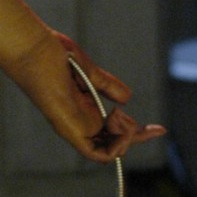Overview[edit]
Following the end of the Cylon War, the Cylons withdrew from Colonial space to a planet of their own. For some 40 years, nothing was heard of them, and no apparent attempt was made by the Colonials to keep an eye on them. The only contact expected between the two was created by the Colonial government through planned annual diplomatic meetings at Armistice Station. However, while the Colonials sent a repesentative to the station every year, the Cylons did not.
During their forty years of isolation, the Cylons developed a bioengineered human form that is indistinguishable from humans, down to human personalities (affection, jealousy, sadness, anger, sense of humor etc.).
These Humanoid Cylon are primarily human in biology. The exception to this is in their entire nervous system. Simply put, Humanoid Cylons don't have an organic nervous system at all. Instead, in the place of nerve cells, the Humanoid Cylons have billions and billions of microscopic "silica pathway" nanomachines linked together in a cohesion subroutine, which includes the Humanoid Cylon brain. All of these nanomachines are configured to mimic neurons in both function and aesthetics. They are sheathed in a bioengineered organic polymer that gives them the appearance of genuine nerve tissue, including brain matter. So essentially Humanoid Cylons are nanotechnology-based lifeforms encased in genetically engineered human shells.
Normal human bodies can't function with a mechanical nervous system, so the Cylons perform very subtle, but specific changes to the genetic code of the humanoid models during engineering that very slightly alters the metabolic processes of the human body to a degree that is not even noticeable, but enables the body to accept the nanomachine nervous system.
Humanoid Cylons can be programmed to believe that they are truly human. These are known as 'sleeper agents'. Sleeper agents have a low-level Cylon personality that can conduct operations while placing the human sleeper personality "on-hold." Most agent copies, particularly Numbers Five and Six, imitate human behavior, but are fully aware of their true nature and behave more or less like a human "spy."
The majority of the Cylons follow a monotheistic religion (with the possible exception of the Brother Cavil model).

Although they cannot do so remotely or wirelessly, Humanoid Cylons can interface with a computer system or computer network through subdermal physical contact with input cables connected to the devices. Caprica-Valerii connected to Galactica's computers by this method when she inserted a fiber-optic cable through her left palm and into her arm. This subdermal fiber-optical link is an interface with the nanotech nervous system. The process involves cutting an opening into the Cylon's palm. It must be not that this is not a common method of data access.
The Cylon nanomachines are susceptible to damage from certain types of radiation. Apparently their program can be corrupted, thereby sending the wrong signals throughout the body's systems; causing fever and eventually death.
To operate, the nanomachines are dependent on the biochemistry of the human shells in a symbiotic connection. This means that if the body dies, the nanomachines become inert. However, the artificial intelligence program is capable of transmitting itself into another nanotech organism encased in a human body (of the appropriate model) i.e. upon the death of a Humanoid Cylon's body, it transfers its consciousness into another copy of itself. This ability is limited by distance, signal integrity, and proximity to a "resurrection node" or, in space, a "Resurrection Ship."
All Cylon agents may share a collective knowledgebase of data from other active or deactivated Cylon agents. However, it is not of a collective consciousness "hive mind" in nature.
Some Cylon female models may have the capacity to bear children seeded by human males. The Cylons tested numerous methods of sexual reproduction, yet these failed due a well known flaw in the Humanoid Cylon design: a genetic quirk caused by the genetic recoding makes procreation between Cylons impossible. So in an attempt to subvert this deficiency, they try to interbreed with humans, creating hybrid offspring. "Farms" were set up across all the occupied Colonies where survivors, specifically, young fertile women of child-bearing age, were rounded up, placed under heavy sedation and turned into "baby machines" through artificial insemination (There are presumably also farms for male humans, plus in vitro experiment labs, etc.). However, this method has been unsuccessful thus far. Another drastically different approach is taken by attempting to conceive a child through a bond of love. It seems that Karl Agathon and Caprica-Sharon Valerii's love-child is the lone success story of the relatively short history of Cylon sexual reproduction.
There are twelve models of Humanoid Cylons, each with many copies, probably tens or hundreds of thousands. The twelve models are based on on archetypes determined by the Cylons that form what they perceive were the specific kinds of human behavior and/or personality, distilled into twelve varieties. Each Humanoid Cylon has the same face, stature, hair, eye and skin color, gender, etc. as all the others of his or her model. The copies apparently start out with the same basic personality, but grow more distinct due to their individual experiences.